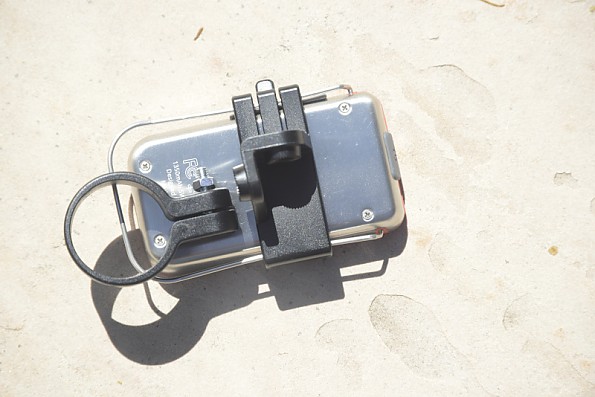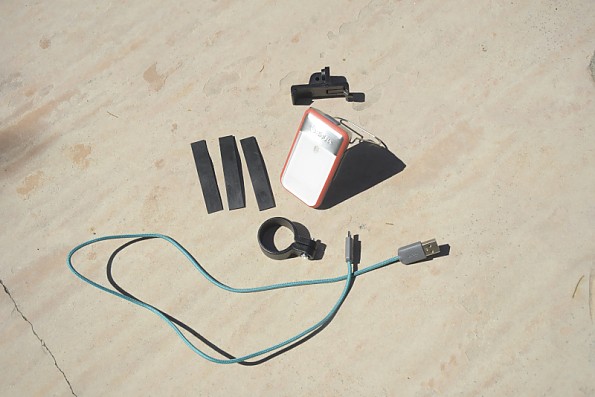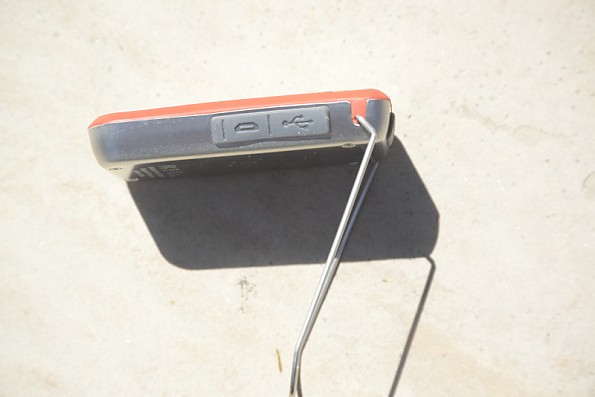BioLite TravelLight 135

Conclusions: The BioLite Powerlight Mini provides reasonable light for use around camp, with the additional benefit of recharge capacity for a cell phone, inReach, handheld GPSR, or small camera, and at a reasonable price. It is readily recharged with a small solar panel, making a total of just over a pound, which is reasonable for a backpacking trip. Heavy use as a night or hiking light or as a recharging source for frequent cell phone or inReach tracking use may require extra backup battery storage.
Pros
- Flexible lighting combined with electric storage.
- Storage capacity enough to accommodate a 3 or 4 day trek (52 hours on reading level white light)
- Red and white emergency strobe beacons
- Compact and Lightweight
- Beamspread is wide enough for night-time trail hiking
Cons
- Switching from one of the 5 modes to another can be complex
- No true spotlight mode – not very good for pre-dawn approaches to climbs
- Storage capacity is skimpy for someone making heavy use of recharging the cell phone or inReach
- May require auxiliary recharge sources (solar panel, large battery storage) for long trips
Background: Whether you spend a long day hiking, months on a through hike, or a multi-day hike, sooner or later you run into a situation where a dependable source of illumination is needed. Over the years, I have used candles, a candle or kerosene lantern, carbide headlamps, butane-powered lanterns, solar-charged lights, and a variety of electrically-powered devices, along with cozy (and not-so-cozy) wood campfires. All have their strong points, and all have their flaws.
Major steps forward over the last couple of decades include halogen lamps and LEDs. A campfire produces warmth and heat for cooking, but leaves a lot to be desired when it comes to light for reading. Lamps can provide adequate light for reading, studying a map, or illuminating your hiking trail.
The BioLite company offers a variety of devices that generate and store electricity for cooking and providing illumination. Since their original products were thermoelectric devices (burning small pieces of wood to generate electricity), many people may not realize that BioLite also produces battery-powered lights that are combined with a storage aspect.
Suggested MSRP - $44.95
Details: When Alicia offered to send me the BioLite for a gear review, my first thought was that this was to be one of BioLite’s well-known wood-burning stoves that includes a thermos-electric generator. For these, you gather small sticks and branches, and burn them to boil water for breakfast or dinner while they generate electricity to re-charge your rechargeable batteries, phone, or other electronic devices. When I opened the package, I discovered that what I got was not the thermoelectric stove, but a small, lightweight lantern with a number of useful talents. The lamp minus accessories easily slips into a small shirt pocket.
The package itself was another story. I guess I should not have been surprised that getting the BioLite out of its wrappings (not including the shipping materials) was a “Chinese Puzzle” (the BioLite, like a lot of other gear, is made in China). I assume that the idea is to discourage the light growing legs and leaving the store. There were 4 wire twists plus overlapping sections of cardboard that had to be undone in the right sequence (or attacking the box with a sharp knife).
Besides the light, the box contained plastic pieces to be assembled to mount the BioLite on your bicycle, a warranty registration instruction card (in 11 languages, only 3 of which I can read, though to actually register the warranty you must go on-line), a small flyer describing BioLite’s very worthy project to bring lighting and electricity to the many parts of the planet that lack these, plus a small flyer labelled “Quick Start Guide” which mainly directed you to getting the instruction manuals on line. Well, it does save paper in this modern age. After reading the parts I can read, I did download the English owner’s manual (which consists mainly of diagrams). As I will note later in the detailed discussion, the directions and pictures were not as informative and clear as they could be. I will describe the mode-switching tangle later.
The main functions, as described in the materials, are power storage (the Power Lite Mini serves as a recharging storage battery) and 5 lighting modes (1) White Lantern, (2) White Lantern+Point Light, (3) Red Lantern, (4) White Strobe, and (5) Red Strobe. (However, paragraph 1 on the instruction sheet says there are 4 lighting modes, and counts the 2 strobes as a single “Red/White Strobe).
As I discovered, switching modes goes roughly in the sequence listed, although there are certain ways to double or triple click the power button to change modes (not all clear in the instructions or repeatable). It took me a fair amount of practice to know when to push the button how many times with what time spacing to change modes.
There are pieces included for mounting the Power Lite Mini on your bicycle. First is a cylindrical clamp to go around the handlebars or seat post. Then, since not all bikes are the same size, there are included 3 rubber strips to be inserted inside the clamp so it fastens tightly (with the supplied machine bolt and nut) on whatever part of the bike you selected.
The pieces supplied with the Mini
To provide both front and back lighting, you would need two of the Mini lights. I believe the now plentiful lamps available at most specialty bike shops are a better choice (I use two lamps that attach to my helmet). The lights are a great idea, considering the rate of bike accidents here in the SFBay Area (several a day on the news).
The BioLite has a wire stand that can hold the light in a standing position or for hanging in your tent. You can also use it to hang the light from your shirt pocket. In the photo below, you can see the cover for the two USB ports — a full size one for recharging your phone, inReach, etc, and a micro-USB for recharging the BioLight itself.
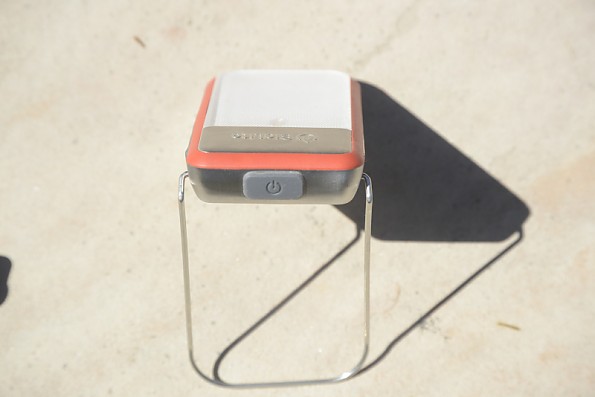
Top view of the BioLite showing the power button that also allows mode changes
Details of testing: One of the first tasks after removing the packaging, activating the warranty (needed to get the full manuals), and reading through the instructions, was (as with any electronic device) charging the BioLite’s battery.
The battery is rated at 1350mAH. After getting full charge (indicated by the 4 LEDs on the side of the lamp being lit), I did some measurements of the lamp’s brightness both directly and off my calibration card, using my Sekonic light meter. Given the agreement with the specs for light output, I set the light for duration measurement with the White Lantern dimmed to its minimum. This meant getting up several times during the 52 hours.
The intensity stayed fairly constant during the first 48 hours, then dropped toward the end, as is usual for the Lithium ion rechargeable batteries. The stated 52 hours is close enough to the 51.5 hours I measured. The 4 LEDs on the right side of the Mini indicate how much power is remaining. I also measured duration with the lamp on full with the Point Light (a small LED at the top center of the screen). As expected, the duration was much shorter (about 4h45m). I did not test the duration in the other modes, but suspect the two strobe modes would be toward the short side.
So, the duration on full brightness is 4h45m, a very useful duration when bright illumination is needed for hiking, and with the main white light set to minimum for reading, providing almost 52 hours, plenty for night-time reading on a long trip.
The “Features List” on BioLite’s website says the Mini can be used as a headlamp. However, the instructions and an examination of the provided accessories give no indication how to mount the light on your helmet or head. Perhaps they mean using the handlebars on your bicycle to mount it as a bicycle headlamp using the supplied plastic pieces, not as a hiking headlamp. You could use the wire stand to hook it to your shirt pocket. I tried this walking down to the neighborhood pizza parlor. While this worked OK for a backpacking shirt, I do not recommend doing this if you are wearing a dress shirt.
BioLite lists the water resistance as IPX4 (rain or splash, but not dunking). I did not do an immersion test to check the water resistance.
I got slightly different dimensions and weight from BioLite’s specs:
Weight: 3 oz /87 gm
Manufacturer: 2.82 oz (80 g)
Size measured: 3.375x1.875x0.625 inches/ 86x50x16mm
Manufacturer: 3.35 x 2.01 x 0.59" (85 x 51 x 15 mm)
The most unique function of the BioLite Mini is its usage as a battery storage unit to recharge your smartphone, MP4 player, inReach, or other device which has built-in batteries and a USB port. I tried recharging several electronic devices, using the BioLite fully charged each time and the device about half-drained. The devices I used were a Samsung Galaxy S5, an inReach SE, and a Nikon S01 point and shoot tiny camera.
The image below shows the BioLite connected and charging my Nikon S01. The Nikon indicates it is receiving power by the blinking red light on the side, while the BioLite indicates it is transmitting charge to the S01 by the 4 white lights. As the supply drains, the upper light starts blinking, then shuts off with the 3rd one blinking and so on. The number of lights indicates how much charge is remaining. That type of indicator is useful when recharging in the field.
A storage battery is extremely useful in the field. You do trade off amount of stored power vs weight — heavier storage batteries generally storing more power. Although the various companies making such batteries caution against using anyone else’s cables, the cables are so standardized these days that usually if the cable is standard USB with a mini or micro USB at the other end, and the cable has been handled carefully and treated gently, there is no problem. Damaged cables, on the other hand can cause shorts and other problems.
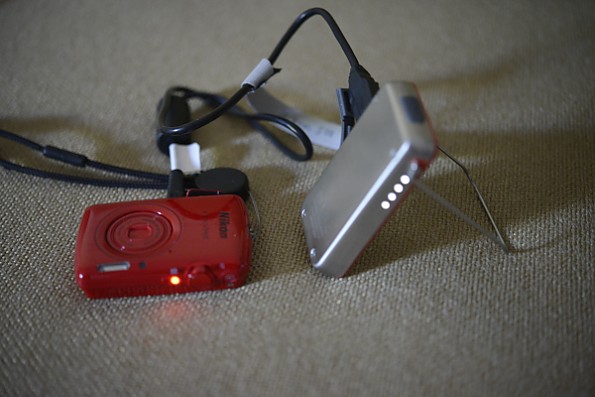
Charging my S01 camera with the BioLite
The following table compares the Biolite with four other storage batteries and two AA cells using the weight I measured on my calibrated scale and the battery capacity claimed by the company:
Battery weight storage mAh per oz
BioLite Mini 3 oz/87gm 1350 mAh 450
Motorola 2.5 oz/71 gm 1860 mAh 744
Aspect Solar 8.125 oz/231 gm 8000mAh 985
Tenergy 8.5 oz/243 gm 8000 mAh 941
Voltaic 19.5 oz/555 gm 20,000 mAh 1025
Energizer AA Lithium 0.5 oz/14 gm 3500 mAh 7000
NiMh rechargeable 0.875oz/26gm 2500 mAh 2860
The value for the Energizer AA Ultimate Lithium (LiFeS2) came from the Energizer Handbook and Application Manual. To say I was surprised by the high energy density of that small AA primary cell is an understatement. To get the equivalent total capacity of the Aspect or Tenergy storage batteries would require 2.3 Ultimate Lithium or 3.2 NiMh batteries (more, actually, since you would need a case with an USB outlet to do the charging at an increased weight — there are such cases available on line)). Keep in mind that the Ultimate Lithium is a 1-time use, and the NiMH requires a recharging method for the batteries.
My Samsung Android S7 has a stated battery capacity of 3000 mAh. So if I were to fully drain the phone (highly NOT recommended), recharging it would fully drain the BioLite. Considering all the factors (heavy weight for the large battery packs, need to recharge or discard the AAs), for a weekend to 3-day outing, the BioLite has the capacity needed for in-camp lighting and a couple recharges of the cell phone. Multi-day, week-long, and thru-hikes would require much larger capacity and sources for re-charge.
The outings I went on using the BioLite were all short (weekend up to 4 days). The BioLite was well suited on those short overnights, in that I had enough power stored in the BioLite to provide light for the evenings, plus enough battery to recharge the inReach and the cell phone. On the other hand, for longer trips, you would need either multiple BioLites or one of the higher capacity battery packs.
A small solar panel, such as the Goal-Zer0 Nomad 7 would probably recharge the BioLite during the daylight hours enough for evenings. If you are sending frequent messages home via your inReach or cell phone, you would need additional battery storage. The weight of AA and AAA batteries for headlamps on the other hand would quickly add up, plus would have to be carried out of the wilderness (Everyone reading this practices LNT, don’t you?).

The combination of solar panel plus BioLite Mini and cable is 16.9 oz/482 gm.
The question I have to ask is “why are you in the woods, anyway? Do you really need to call home multiple times a day? Do you need constant tracking of your position by the folks back home? Or do you get out to enjoy the wilderness?”
On all the trips I took during the test period, the BioLite PowerLight Mini provided enough light and sufficient recharge of the phone, without resorting to other backup methods (no solar, no large storage battery usage). I did start at the trailhead in each case with a fully charged BioLite, cell phone, and inReach.
Operation: The first challenge was deciphering the instructions. The downloaded instruction sheet is mostly diagrams. Some of the written instructions are inconsistent. The instructions state that the Mini is packaged in a Demo mode. They actually mean that it is set to start in a mode to step through the 5 lighting modes.
To see the Demo, you click the button on the top of the Mini’s case and repeat at 1-second intervals (they state 2 seconds) to go through the 5 modes with the last click turning it off. To get to the mode you want, you stop clicking when it appears.
If you pause more than a couple seconds, the next click will turn the light off. Depending on your pause for the next click, it may turn on to the last mode or it may jump back to the initial “White Lantern”. I spent quite a bit of time trying different spacings, including double clicks, single click followed by a fast double click. Eventually I caught on to the rhythm.
The video illustrates a number of the operational points. Keep in mind as you view it that I am far from being a professional cinematographer. The lighting is on the dark side because I wanted to have the coloration of the light (the Red Lantern and Red Strobe in particular) visible.
There is no way to back up or to go directly to a chosen mode. You must go in a linear fashion. The instruction sheet lists 5 modes, although the instruction sheet in the written section describing lighting, says “4 lighting modes”, with a reference to Figure 2.1, which shows 5 modes plus the dimming White Lantern.
If you turn on the White Lantern, then pause for a couple seconds, you can dim the white light by holding the button down. When you reach the minimum light, you see a double flash. You can hold the button down to brighten back to the full White Lantern. The “Point Light”, “Red Lantern”, and two strobes do not allow dimming (the instructions imply that the Red Lantern can be dimmed like the White Lantern, but holding the power button down for 7 seconds or so just shuts off the Red Lantern with no dimming.)
Since you have to step through the modes to select the one you want, I eventually found that you could step more readily in most cases by doing a single click, pause a second, then double click. You will have to practice a while to get your clicks and spaces consistent.
While the Point Light adds a lot to the brightness of the white light, it is not a spotlight, but is more of an overall increase in brightness. The following photo was taken of the apricot tree in my back yard with the White Lantern + Point Light at a distance of 25 feet. If you look very closely at the plum tree in the shadow to the right, you may be able to make out some of the 50 pounds of plums we got this year (it was an off-year for this apricot tree, although the other apricot tree produced about 20 pounds).
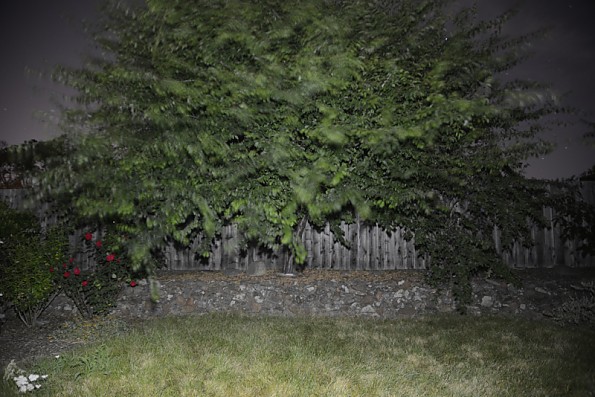
Backyard apricot tree lit at 25 feet with the BioLite Mini at full White Lantern+Point Light brightness
One potential caution: While sitting around the campfire during a recent climbing trip to Donner Pass, several of us got into a discussion of headlamps, battery usage, and other items requiring electricity. I described and showed the BioLite Mini. The group were favorably impressed until I started going through the various modes. One of the other climbers was very perturbed by the white and red strobes.
Apparently some people can have an epileptic seizure triggered by strobe lights operating at certain frequencies. I did not measure the frequency of the strobe settings, and the only thing I know about this effect is having seen a brief mention of it some time ago. I and most of the people around the campfire were not particularly bothered by the strobing (although the light in full-on white plus point mode was bright enough that we weren’t looking directly into the light). I believe that it is only necessary to not shine the light directly in the eyes of anyone, especially when the night is fairly dark, giving a huge contrast between the lamp and the dark surroundings.
Conclusions: The BioLite Powerlight Mini provides reasonable light for use around camp, with the additional benefit of recharge capacity for a cell phone, inReach, handheld GPSR, or small camera, and at a reasonable price. It is readily recharged with a small solar panel, making a total of just over a pound, which is reasonable for a backpacking trip.
Source: received for testing via the Trailspace Review Corps
(Sample provided by BioLite for testing and review)
Just picked this up and love the flexibility of the product.
Pros
- Great charging option without requiring a separate power pack
- Wonderful travel light
Cons
- May be redundant if a headlamp is already part of your gear
I don't see this as a replacement for a good headlamp when trekking in darkness and more focussed light is required. However, for a great tent light or travel light, this is fantastic. Adding the capability of a supplementary power source makes it even more versatile.
Source: received it as a personal gift
Your Review
Where to Buy
You May Like
The TraveLight 135 was previously marketed and sold as the BioLite PowerLight Mini.
Specs
| Price |
MSRP: $39.95 Historic Range: $21.77-$44.95 |
| Weight |
2.82 oz / 80 g |
| Lumens |
135 |
| Burn Time (hours) |
52 LO / 5 HI |


